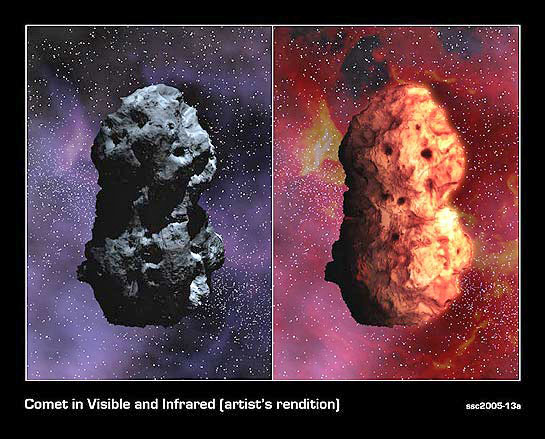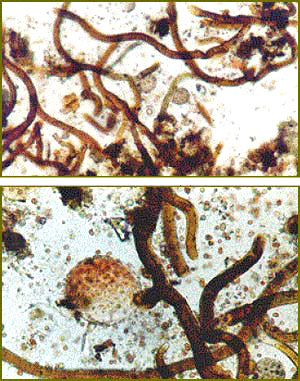|
by David Tenenbaum
That's the startling word from Kerala, India, where physicist Godfrey Louis has studied a peculiar, blood-red rain that fell in 2001.
In summer, 2001, red rain fell in this 150 km by 450 km area of southwestern India.
Data from "The Red Rain Phenomenon..."
Louis, of Mahatma Gandhi University, Kottayam, India, told us in a brief email that the red rain fell on his hometown of Kottayam, "and I was immediately interested."
Under a microscope, the rusty-red
water contained thick-walled objects that looked like cells. The
cells had no nuclei, but they did contain structures that resembled
the tiny organelles inside familiar cells.
The details on replication are being submitted to another journal. Louis's study, published in March (see "The Red Rain Phenomenon ..." in the bibliography), also claimed that:
The first red rain occurred hours after local people heard a loud,
cracking sound -- possibly the high-altitude explosion of a small
meteor. The elliptical pattern of red rainfall resembles the pattern
of fragments when a meteor strikes at a low angle -- but no meteor
fragments were found.
Two cells (or is that three?) seem to be forming inside this cell, taken from the red rains of Kerala.
Courtesy CCAB, Cardiff
University
The Louis report tried to answer obvious objections to the alien theory.
For example, why didn't the cells rain out right away? Louis calculated that they would slowly drift down, taking up to 60 days to reach Earth's surface. The idea that one body of air would blanket Kerala for 60 days caught the eye of Ian Goddard, an independent researcher who wrote a debunking of the red-rain-as-aliens.
Goddard wrote us to say,
It's "simply preposterous" to argue that these microscopic particles would slowly rain out of the atmosphere for two months, he wrote.
Dusty?
Lynn Rothschild, an
associate professor of human biology at Stanford University and
editor of the International Journal of Astrobiology, questions the
reliability of the Cardiff claims, which should, she say, have been
performed under a microscope.
We emailed Cardiff astrobiology director N.C. Wickramasinghe for clarification, but he never got back to us.
These artist's concepts of comet Tempel 1 simulate optical (left) and infrared views. This comet is roughly 14 by 4 kilometers. If a comet spread alien cells across India in 2001, it could have been just 10 meters across.
Images: NASA, Jet Propulsion
Laboratory-Caltech, and T. Pyle (Spitzer Science Center).
To Louis, the red rain seems to bear out a controversial theory of "panspermia" that Wickramasinghe helped develop -- that comets "seeded" the universe with life.
In other words, radioactive decay
may keep the comets warm enough to allow life forms to stay alive -
and we could be the descendants of ET.
Did aliens reach India on a comet?
Goddard pointed us to a 2001 report from India (see "Coloured Rain: ..." in the bibliography), which noted that red rain had previously fallen in Kerala. The report concluded that the rainfall contained spores of a lichen-forming alga in the genus Trentepohlia.
Lichen are symbiotic
relationship between fungi and algae. The spores of both organisms
can survive harsh environments like deserts, frigid polar regions,
and alpine rocks, where they are bathed in powerful ultraviolet
light.
When these samples were grown in culture,
The 2006 Louis report did mention the above article, but mischaracterized it slightly as the discovery of "fungal spores," not algal spores.
However, Louis ignored a 2002 report from India's Centre for Earth Science Studies (see "Colored Rain Falls in Kerala..." in the bibliography), which also concluded that the red color came from algae. In general, scientists who make new claims must discuss and refute existing claims that they disagree with.
When Indian scientists placed cells from the red rain on a growth medium, they identified a lichen-forming alga.
Photos: Tropical
Botanic Garden and Research Institute, India (see "Coloured Rain..."
in the bibliography).
Another scientific fraud?
Although the samples were too
old to be definitive, that claim is now largely discredited; some
scientists suggested the yellow tint came from bee dung.
Eventually, Science, the premier American scientific journal, had to yank two fraudulent articles on major stem-cell advances.
In 1996, a furor arose after a scientist claimed these "Martian fossils" were evidence of life on Mars. Nobody knows for sure, but the rock apparently did come from Mars. Did a comet carry life to Earth -- in the deep past or in 2001?
Photo: NASA.
The claims for life on Mars and life-saving advances in stem cells
appeared in prestigious scientific journals. Likewise, Louis's 2006
article was published in a "prestigious peer-reviewed journal," as
CNN described it.
In peer review, outside scientists gauge an article's accuracy before publication. Articles that survive peer review are deemed the "gold standard" of science, even though the claims about Martian life, stem cells, and alien red rain all passed peer review.
Revealed - Scientists are humans, too!
And thus Blum suggests this straightforward rule for evaluating an outlandish scientific claim:
For our part, call us flying-saucer traditionalists, but we remain
skeptical that red rain is carrying aliens. The claim would be
sturdier if it had passed a deluge of skepticism and study that
greeted the Martian meteorite.
Where is the extraordinary evidence for
alien red rain?
|





